Okinawa food
Okinawa is not Japan. The southern island culture is a colorful cornucopia of Chinese influences and indigenous Ryukyu Kingdom practices. It is colorful, exotic and vibrant, and naturally the food reflects this spirit. A rainbow of blue parrotfish, red snappers and orange lobsters are roasted whole on outdoor grills. The side dishes are unique — pig ear salad, crunchy little bubbles of seaweed and purple yam rice – from hoofs to roots, the variations of Okinawan ingredients are exhaustive.
The food of Japan’s southern islands is probably best known worldwide for promoting longevity. The New York Times bestselling book, “The Okinawa Program,” was written by doctors researching this native diet rich in protein, vitamins, minerals and antioxidants. Despite its healthy connotations, there is nothing bland about Okinawan cuisine, which is rich with flavor and complex in texture.
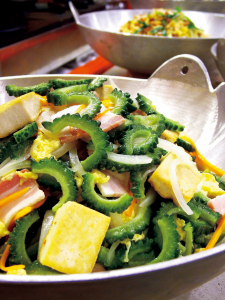 The most popular casual Okinawa has to be the “chanpuru.” Meaning “a mixture of”, it is chop suey with egg and tofu stir-fried with an assortment of ingredients including goya, a bitter melon, low in calorie but rich in vitamins and polypeptide-p, a substance known to lower blood sugar levels. Other ingredients around the kitchen such as pork, canned tuna, bean sprouts and other leftover vegetables can be included.
The most popular casual Okinawa has to be the “chanpuru.” Meaning “a mixture of”, it is chop suey with egg and tofu stir-fried with an assortment of ingredients including goya, a bitter melon, low in calorie but rich in vitamins and polypeptide-p, a substance known to lower blood sugar levels. Other ingredients around the kitchen such as pork, canned tuna, bean sprouts and other leftover vegetables can be included.
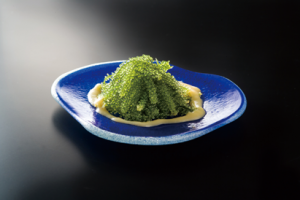 Seaweed is said to contain the broadest range of minerals of any food such as potassium, calcium, magnesium, iron, and iodine. Okinawa cuisine always includes some type of sea plant such as mozuku or umibudo. Umibudo, called sea grapes or green caviar, is an Okinawan specialty. There is no distinct flavor except for a bit of a seaweed taste. What makes this food appealing is its texture which is like having liquid bubbles bursting in your mouth like caviar. Eaten raw and seasoned with a dressing, it is usually served in salads or sometimes as an Okinawan-style sushi topping.
Seaweed is said to contain the broadest range of minerals of any food such as potassium, calcium, magnesium, iron, and iodine. Okinawa cuisine always includes some type of sea plant such as mozuku or umibudo. Umibudo, called sea grapes or green caviar, is an Okinawan specialty. There is no distinct flavor except for a bit of a seaweed taste. What makes this food appealing is its texture which is like having liquid bubbles bursting in your mouth like caviar. Eaten raw and seasoned with a dressing, it is usually served in salads or sometimes as an Okinawan-style sushi topping.
Of course, seafood is a major part of Okinawan cuisine. The fusilier fish, gurukun, is a small snapper usually with yellow and blue stripes on its back. It can be viewed swimming in large schools by snorkelers all along the island’s shoreline. It is also a tasty fish to eat, either as sashimi or deep-fried. Tuna is also popular, but around Okinawa, it is a smaller, leaner fish compared to their bigger relatives found in northern Japan.
Although surrounded by water, meat plays a big part in Okinawan cuisine. Marbled Ishigaki beef can be found in expensive teppanyaki restaurants across the islands, but pork is definitely the mainstay meat. Everything from the face to the entrails of the animal is served in one way or another. The entry level Okinawa pork dish has to be rafute, pork belly stewed in sugar cane and the Okinawa native liquor awamori. It is a dish that can be found in fancy multiple course restaurants as well as at roadside diners.
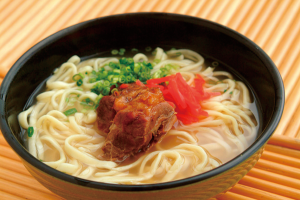 Rafute is often a topping for Okinawa soba, the favorite quick meal of the islands. The wheat noodles are thick and yellow and the soup stock is usually a blend of pork bones with a fish base. Despite the hot weather, Okinawa soba is never served cold. Rather it is served with a tall glass of tumeric tea. Turmeric is the spice that gives the bright yellow color to curry. As a tea with the flavor of a slightly bitter liquid curry, it is definitely an acquired taste. But with health benefits such as liver detoxification, turmeric tea always manages to find new converts.
Rafute is often a topping for Okinawa soba, the favorite quick meal of the islands. The wheat noodles are thick and yellow and the soup stock is usually a blend of pork bones with a fish base. Despite the hot weather, Okinawa soba is never served cold. Rather it is served with a tall glass of tumeric tea. Turmeric is the spice that gives the bright yellow color to curry. As a tea with the flavor of a slightly bitter liquid curry, it is definitely an acquired taste. But with health benefits such as liver detoxification, turmeric tea always manages to find new converts.
A far more refreshing beverage to consume is shikuwasa juice, Okinawa’s version of lemonade. The shikuwasa is a small lime-like citrus fruit and its juice is used to flavor everything from seafood to ice cream. This juice can also be served with awamori, the island’s favorite liquor made of distilled rice that can have up to 45% alcohol content. The longer it is aged in clay pots, the more refined and mellow the taste becomes.
Peanuts and purple yams are other Okinawan staples. The island’s jimami dofu is a peanut based tofu with white agar to give it a firmer, jelly-like texture. Usually served with a thick, sweet yet savory sauce, because it comes in small portions, one is always left wanting more of it.
The purple yam is another popular island food. Rich in vitamins, minerals and fiber, it is regarded as a cornerstone of why Okinawa food promotes longevity. Usually served in some form of dessert like a sweet soup, pie or as an ice cream flavor, in Okinawan kaiseki course meals, it is deep fried as tempura and served with sea salt instead of a sauce.
Tokyo has a plethora of good authentic Okinawan restaurants. Most serve casual dishes like chanpuru, seaweed salads and Okinawa noodles with plenty of awamori flowing at night. There is also Okinawan haute cuisine honored by the Michelin restaurant guide like Akasaka Tantei. Like traditional Japanese kaiseki, tiny portions of food are served in a variety of dishes from lacquered plates to handmade bowls and desserts in Okinawa style hand. Rafuti, gurukun, goya, and jimami tofu are all usually featured along with some dishes that are time-consuming to make such as fish paste steamed with yam shaped into a ball and served with a delicate sauce. What also makes kaiseki cuisine exquisite is the creativity used. At the Renaissance Okinawa Resort in Okinawa, as part of a course meal, I was served a plate of sushi, not made from fish, but from local vegetables. The colorful dish included marinated bitter melon slivers, pickled onions and sea grapes as toppings.
A less common Okinawan meal would be the Ryukyu Imperial food. Presented in a compartmentalized lacquered container, it resembles Japanese New Year’s cuisine with preserved foods in bite size portions. Requiring extensive preparation time, representative food includes seaweed wrapped pork, smoked sea snake and fish paste in a colorful palette.
In Okinawa’s native dialect, there is a term “nuchi gusui” which means that medicine is in everyday food. The delicious medicine the islanders take daily not only contributes to their longevity but also makes them smile brightly and laugh loudly. Whether it is in a Tokyo restaurant or down in the islands, eating Okinawa food is a foray into a foreign voyage within Japan.
By Carol Akiyama
From WINING & DINING in TOKYO #41



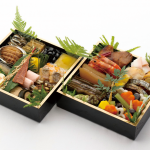
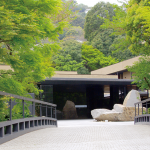
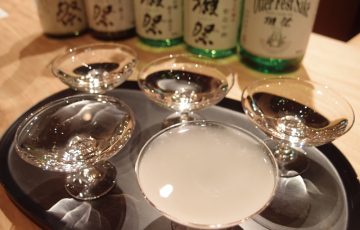









Recent Comments